Porter’s Generic Strategies explained

Porter’s Generic Strategies: this article explains the Porter’s Generic Strategies by Michael Porter in a practical way. It covers what the strategies are, how to apply them and how to choose the right strategy. It also contains an in-depth explanation video. Enjoy reading and watching!
What are Porter’s Generic Strategies? The theory
The Generic Strategies can be used to determine the direction (strategy) of your organisation. Michael Porter uses 4 strategies that an organisation can choose from. He believes that a company must choose a clear course in order to be able to beat the competition.
The four strategies to choose from are:
- Cost Leadership strategy
- Differentiation
- Cost Focus
- Differentiation Focus
Michael Porter described the theory in his 1985 book Competitive Advantage: Creating and Sustaining Superior Performance. The basis was formed by three strategies, namely cost leadership, differentiation and focus. He divided the latter into cost focus and differentiation focus.
Porter’s Generic Strategies Video (1-Minute Skill Booster)
Our 1-Minute Skill Booster below will help you get a quick overview on Porter’s Generic Strategies and at the end of this article you will find an in-depth video on this strategy theory.
How to apply Porter’s Generic Strategies?
According to Michael Porter there are four generic strategies:
1. Cost Leadership strategy
Choosing the cost leadership strategy, you target a broad market (large demand) and offer the lowest possible price. There are 2 options within this cost leaders strategy. You can opt to keep costs as low as possible; or ensure that you have a larger market share with average prices.
In both cases, the point is to keep the company costs as low as possible. The consumer price is a different story.
Organisations that apply this strategy successfully usually have substantial investment capital at their disposal, efficient logistics and low costs when it comes to materials and labour.
The organisation is generally focused on internal processes.
2. Differentiation
You target a broad market (high demand), but your product or service has unique features. With this strategy, you make your product as exclusive as possible, making it more attractive than comparable products offered by the competition.
Succeeding using this strategy requires good research & development, innovation and the ability to deliver high quality. Effective marketing is important, so that the market understands the benefits of your unique product.
It’s important to be flexible and to be able to adapt quickly in a changing market, or you risk the competition beating you at it. Such an organisation is focused on the outside world and has a creative approach.
3. Cost Focus
You target a niche market (little competition, ‘focused market’) and offer the lowest possible price. In this strategy, you choose to target a clear niche market and through understanding the dynamics of these market segments and the wishes of the consumers, you can ensure that the costs remain low (cost advantages).
An example of low cost producers like this are the low-cost budget airlines that achieve market share growth by choosing cost focused strategies like offering cheap, basic services at lower prices than the big airlines that charge much higher prices.
4. Differentiation Focus
Choosing the differentiation focus strategy, you target a niche market (little competition, ‘focused market’) and your product or service has unique features. This strategy often involves strong brand loyalty among consumers.
During the focus on differentiation, it’s very important to ensure that your product remains unique, in order to stay ahead of possible competition.
In order to choose the right strategy for your organisation, it’s important be aware of the competencies and strengths of your company.
Porter’s Generic Strategies: choose the right strategy
You can follow these steps to choose the right strategy:
Step 1
Do a SWOT analysis for your business. This will clarify your strengths and weaknesses as well as highlight opportunities and threats.
Step 2
Try to truly grasp the market of your industry. This can be done, for example, through the Five Forces Analysis, a model also developed by Michael Porter, designed to determine profit potential. The 5 forces that influence this are:
- the (power of) suppliers;
- the (power of) the customers;
- the availability of comparable products;
- the threat of new entrants;
- and internal competition.
Step 3
Compare your SWOT analysis with the outcomes of step 2. For each of Porter’s strategies, ask yourself how you might use that strategy to influence the previously mentioned five forces. On that basis, determine which strategy offers you the best starting point (and profit potential).
Critical comments
Porter stressed the idea that only one strategy should be applied by an organisation in order to prevent a “stuck in the middle” scenario. However, a model in which you opt for just one single strategy certainly also raises criticism. For example, the model isn’t particularly flexible.
There are plenty of companies that opt for a more ‘hybrid’ strategy, i.e. making use of different (components) of Porter’s 4 general strategies. In a rapidly changing market, this flexibility, the ability to switch quickly and respond to the market and the demand, seems to be an important element to running a successful and long term business.
To summarise Porter’s Generic Strategies
Porter’s Generic strategies can be used to determine the direction (strategy) of your organisation. There are four strategies an organisation can choose from.
The four strategies to choose from are:
- Cost Leadership
- Differentiation
- Cost Focus
- Differentiation Focus
An understanding of the market, your industry and your own organisation are paramount in choosing the right strategy.
Porter’s Generic Strategies video (in-depth explainer)
Watch the in-depth video below for a recap of what you’ve just read, so you will remember it more easily!
Now it’s your turn
What do you think? Could Porter’s Generic Strategies benefit your business? Or are you more into the ‘hybrid’ style? Share your knowledge and experience via the comment field at the bottom of this article.
Share your experience and knowledge in the comments box below. Feel free to also leave a rating for this article and perhaps give our 1-Minute Skill Booster on Porter’s Generic Strategies a thumbs up, if it was useful.
More information
- Jennings, D. F., & Lumpkin, J. R. (1992). Insights between environmental scanning activities and Porter’s generic strategies: An empirical analysis. Journal of Management, 18(4), 791-803.
- Kim, E., Nam, D. I., & Stimpert, J. L. (2004). Testing the applicability of Porter’s generic strategies in the digital age: A study of Korean cyber malls. Journal of Business Strategies, 21(1), 19.
- Murray, A. I. (1988). A contingency view of Porter’s “generic strategies”. Academy of management review, 13(3), 390-400.
- Porter, M. (1998). Competitive Advantage: Creating and Sustaining Superior Performance. Free Press.
How to cite this article:
Kuijk, A. (2018). Porter’s Generic Strategies. Retrieved [insert date] from Toolshero: https://www.toolshero.com/strategy/porters-generic-strategies/
Published on: 05/10/2018 | Last update: 11/08/2023
Add a link to this page on your website:
<a href=”https://www.toolshero.com/strategy/porters-generic-strategies/”>Toolshero: Porter’s Generic Strategies</a>














8 responses to “Porter’s Generic Strategies explained”
Very useful post. This is my first time i visit here. I found so many interesting stuff in your blog especially its discussion. Really its great article. Keep it up.
Thank you for your feedback Zerry. I am glad that you found this article useful.
good work. excellently explained in easy language.
i would love to read a post on hybrid style written by you.
Thank you for your feedback Jerry. I am glad that you found the article helpful.
Very helpful essay. Good work keep it up!
Thank you for your comment, Lai Chi.
The provide information was quite useful and as well composed in a really simple form. It is a great job Sir! carry on this great work.
I read the article and find it interesting. Thanks.